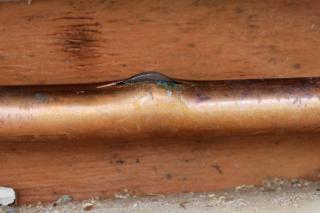Prevent Frozen Pipes

Winter weather and cold temperatures can wreak havoc on household plumbing. As the homeowner, you are responsible for the protection of your home's pipes and meters and for any damage to them.
Pipes and meters are located against exterior walls or often in unheated basements or crawlspaces, they are vulnerable to freezing temperatures. In freezing temperatures, metal pipes contract as the water expands. This is what causes pipes to burst.
Below are tips that will help you protect yourself from costly plumbing repairs:
- Insulate pipes. Be sure to insulate pipes in any unheated areas of your home. One way to insulate your pipes is using heat tape or pipe insulation. These items can be purchased at a local home improvement store. Indoor water meters can be wrapped with a blanket.
- Protect your meter. If you have an outdoor meter pit, make sure the lid is not broken or missing. Pack the pit with insulating material, or even an old blanket.
- Eliminate drafts. Close off crawlspace vents and doors. Repair broken or cracked basement windows. Make sure basement doors and windows close tightly. Repair any broken or cracked basement windows.
- Drain exterior faucets. Shut off and drain any outside faucets, including those for lawn sprinkling systems.
- Locate main water valve. Locate and visibly mark the home's master water valve. In the event that a pipe does break, use this valve to turn off water to the home.
If temperatures drop to close to 10 degrees Fahrenheit be sure to do the following:
- Check the water temperature by placing a thermometer under the tap.
- Leave a very thin stream of water running constantly from at least one tap. We recommend using the tap farthest from the meter. The additional expense in your water bill will be minimal compared to the cost to replace a ruptured pipe.
- Open cabinet doors below all sinks to allow the warmth from the inside of your house to reach your pipes. Before you follow this tip, be sure to remove all harmful items from beneath the sink.
- Make sure to have a supply of heat tape and pipe insulation, as well as portable space heater and a hairdryer on hand. Proper and safe use of portable space heaters can also keep exposed pipes in drafty areas from freezing.
- Customers can thaw areas of frozen pipe by using a hairdryer. Hold the dryer six inches from the pipe and move the warm air back and forth. If this does not work, or the pipe is split, call a plumber.
Place this information on your refrigerator during the winter. Following these tips can save you a great deal of money.
Remember, you are responsible for the pipes inside your home.

